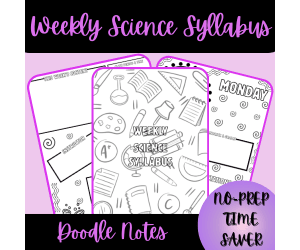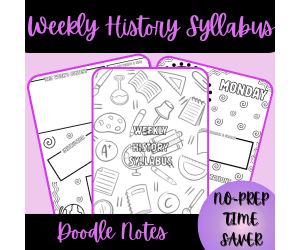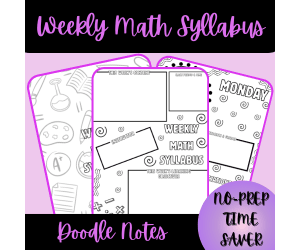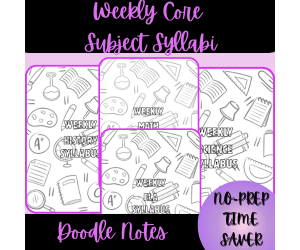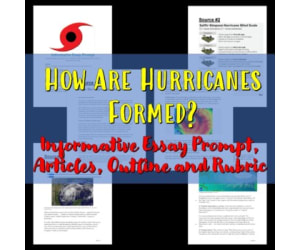2,761 products added recently
Writing Outlines
Writing Outlines provide a roadmap for students embarking on writing assignments. These templates assist in organizing introductions, thesis statements, supporting arguments, and conclusions. By breaking down the writing process, students can focus on developing content and style effectively. Writing Outlines are adaptable for various genres and grade levels, making them a versatile addition to your teaching resources. Empower your students to write with confidence and clarity using these helpful tools.
Weekly Science Syllabus Doodle Notes
ELA, Writing, Graphic Arts, Creative Arts, Science, High School, Homeschool Resources, Middle School, Worksheets & Printables, Writing Prompts, Teacher Tools, Graphic Organizers, Templates, Outlines
Are you ready to breathe new life into your science lessons? T hese Weekly Science Syllabus Doodle Notes were born out of my own frustration as a homeschool mom trying to juggle curriculum planning while keeping my kids actually interested in science. Trust me, I have spent countless late nights staring at bland planning sheets thinking, "There has to be a better way!" After one too many uninspiring science lessons, I created these templates that have completely transformed how we approach science in our homeschool. These are not just another pretty printable—they are the answer to that moment when you realize your kiddo has retained exactly zero information from last week's lesson on photosynthesis! I have designed them to be your visual playground, where mapping out experiments and research activities becomes something you and your students/homeschoolers actually look forward to. My own teenage daughter went from groaning about science to pointing at their doodle notes saying, "Remember when we did that cool experiment?" The secret sauce? These notes engage both the logical and creative sides of your brain, which means those scientific concepts finally stick—no more blank stares when you ask, "Remember what we learned last Tuesday?" These have been a game-changer in our homeschool, and I can't wait for them to transform yours too! INCLUDED IN THIS RESOURCE: ✔Comprehensive weekly science planning template with visually engaging design ✔Designated spaces for scientific learning objectives, content focus, and instructor information ✔Daily sections for documenting science classwork, lab activities, quizzes, and attendance ✔Specialized reading assignment sections for scientific texts and research articles ✔Homework planning areas with website research recommendations and writing prompts ✔Visual note-taking spaces that connect scientific concepts with creative representation ✔Structured organization that accommodates the unique needs of science instruction Sunday nights used to be my nightmare—frantically scrambling to plan science lessons while dreading the glazed-over looks I would get from my teenager the next day. Sound familiar? Those days are OVER! With these Weekly Science Syllabus Doodle Notes , I have actually caught myself looking forward to planning time (weird, right?). Let me tell you, juggling high school science with a creative teen who'd rather be doing anything else pushed me to my breaking point. My kitchen table was buried under boring worksheets that neither of us was excited about. That is when I decided to create these templates—not because I am some super-organized homeschool mom (ha!), but because I desperately needed something that would work for both my planning sanity AND my visually-oriented teenager. The magic happens when organization meets creativity! Now my daughter can actually see what is coming each week, and those complex scientific concepts finally stick because the visual elements speak her language. I still cannot believe how much easier our science days flow now! Seriously, grab these today—your future bleary-eyed, lesson-planning self will high-five you when you realize science class has transformed from a battle to the highlight of your homeschool week! If you and your students/homeschoolers enjoyed this resource, please leave a review. Thank you for your support! Tina - Big Easy Homeschooling Mom Website: tidewindacademyhomeschool.com
Author Homeschool with Big Easy Homeschooling Mom
Rating
Tags Visual Aids, Visual Learning Tools, Weekly Planning Template, Science Planning, Science Syllabus, Creative Syllabus Templates For Science Students/homeschoolers, Science Curriculum Organizer, Creative Teaching Tools, Homeschool Science Organization, Homeschool Planning
Writing Literary Analysis Step-by-Step Directions & Outline Activity
ELA, Writing, Grade 8, 9, 10, 11, 12, Outlines, Teacher Tools
What's the method to craft a literary analysis? More importantly, how can you impart the art of writing literary analysis to your students? This manual unravels the process of creating a literary analysis essay through clear, incremental instructions and a plain drafting exercise, addressing key areas such as thesis statements for literary analysis, assertions and justifications, opening sections, structuring of body paragraphs, incorporation of quotes, analysis suggestions, and conclusion writing. Teaching the craft of literary analysis writing can be a daunting task; allow this tool to make it easier for you! This is an excellent reference and essay-writing reference material that your students will appreciate whenever tasked with writing a formal literary analysis essay for your class. The guidelines break down each step of the writing process, from thesis development to introductions and body paragraphs before cleverly supplying tricks and options that will unlock the mysteries of writing a strong conclusion. Included in your download is: - 4 pages of step-by-step literary analysis writing guidelines (Page 1: Thesis Statements; Page 2: Introductions; Page 3: Body Paragraphs; Page 4: Conclusions). Each page is designed to be aesthetically pleasing and easy to follow. Many instructors laminate these pages to provide students with a reference material they can keep and use for years - A two-page summary handout for student reference that addresses everything in the writing guidelines in a clear and concise, text-only format - An essay outline activity that combines our step-by-step guidelines with essay drafting practice. This is a perfect resource that can assist students with nearly any literary analysis writing assignment they might encounter from middle school through higher education. Although this resource can be fitted for any secondary Language Arts classroom, it has been carefully designed to work best in grades 9, 10, 11, and 12. These step-by-step guidelines are specifically tied to Common Core ELA Standards for Writing (1, 2, 4, and 9) and Reading Information (4). This resourceis provided as a print-ready, bookmarked, and adjustable PDF file. This resource contains 9 pages.
Author The Language of Educational Art, LLC
Tags Literary Analysis, Essays, Directions
Daffodils Kindergarten Science Projects + Lesson Outline
Science, Life Sciences, Nature & Plants, Writing, ELA, Creative Writing, Kindergarten, Grade 1, Teacher Tools, Outlines, Parts of and Anatomy of, Worksheets & Printables
Take the humble Daffodil and transform it into an engaging Kindergarten Science Project that your pupils will love this spring. You will be able to cover much of the Curriculum for Science (Plants) without your pupils knowing they are learning. Suggestions are made and resources are provided to enable you to integrate your science work with language (poetry) and creativity. Who is it for? This Daffodils Science project is intended to be used with Kindergarten and Grade 1 children. Home educators can also use it in the course of nature study/Science learning. What does it contain? · PowerPoint The pack comes with an 18-slide PowerPoint, which can be used to either start your lesson or as a recap at the end. The PowerPoint begins with the bulb under the ground waiting for spring, and then shows how the Daffodil grows. It teaches about the parts of a Daffodil: the bulb, stem, leaves, buds, calyx (the papery covering protecting the buds), petals, trumpet and pollen. The PowerPoint is a taught lesson and comes with sound. · Lesson outlines Two lesson outlines are provided, one for ages 5-6 and another for ages 6-7, though other ages might also benefit. It can be used successfully with mixed age-range classes. Notes as to how to dissect a Daffodil. · Worksheets/Activities · Label the parts of a Daffodil. · 5 pages to make a Daffodil diary: choice of coloured or black/white front cover. Let the children make observations of a Daffodil growing near them that can be observed easily. · Poetry work – read the poem ‘Daffodils’ by William Wordsworth (provided) and use our suggestions to think about the poem. · Acrostic worksheets for pupils to write their own Daffodils acrostic poem. · Daffodil writing paper For display: Beautiful original photos · A5 photos of parts of a Daffodil · A4 pictures and vocabulary cards for Daffodil Life Cycle: use for Science work, language or display, word walls, etc… · Display headers What is included? 1 18-slide PowerPoint 1 PDF file with 47 pages
Author Lilibette's Resources
Rating
Tags Daffodils, Daffodils Life Cycle, Daffodils Science, Daffodils Plants Lesson, Daffodil Life Cycle, Kindergarten Science Projects, Nature, Plants, Parts Of A Flower
What are Myths, Fables, Legends, and Fairy Tales?
ELA, Literature, Reading, Writing, Grade 3, 4, 5, Drawing Templates & Outlines, Worksheets & Printables, Worksheets, Graphic Organizers, Teacher Tools, Outlines
Brief Activity Overview: In this activity, your child will explore the unique features of myths, fables, legends, and fairy tales . They will watch a short video and use a chart to organize what they’ve learned about each type of story. At the end of this document, be sure to check out the "Beyond the Activity" section for fun extension ideas if your child wants to dive deeper into these story types or try related lessons. Estimated Time: Less than 1 hour Learning Objective: Understand and identify key features of myths, fables, legends, and fairy tales. Subject: English Language Arts Recommended Grade Levels: 3rd – 6th Getting Started: Exploring Story Types Begin by engaging your child in a simple conversation to spark interest and activate prior knowledge: Tell me about one of your favorite storybooks. Suggested discussion questions are included as great way to ease into the lesson and connect your child’s personal reading experiences to the bigger ideas behind storytelling. Introducing the Activity Discuss how many stories fall into categories such as myths, fables, legends, and fairy tales and what your child knows about them (guiding questions are provided). Then, explain that in this activity, they’ll learn more about each type by watching a brief video and taking notes. Encourage them to pay attention to the key features of each story type and notice how they are alike and different . What to Do Next Watch the Video – Invite your child to watch the short video provided. Take Notes – As they watch, encourage them to jot down what they learn about myths, fables, legends, and fairy tales. Discuss and Reflect – After watching, go over the comprehension questions on the next page. These questions can be used: As discussion starters As writing prompts Or a combination of both—whatever works best for your family! 💡 An answer key is included to support your discussion.
Author Sprout & Inspire
Rating
Tags Reading, Myth, Fable, Legend, Fairy Tale, Graphic Organizer, Quick Activity, Ela
Weekly ELA Syllabus Doodle Notes
ELA, Writing, Resources for Teachers, High School, Homeschool Resources, Middle School, Worksheets & Printables, Writing Prompts, Teacher Tools, Graphic Organizers, Outlines, Templates
Imagine jazzing up your language arts planning with these Weekly ELA Syllabus Doodle Notes . They are not just templates; they are a fun way for teachers and students alike (including homeschoolers!) to dive into learning. Think of them as beautifully designed organizers that blend pictures with practical planning. T his combo makes mapping out your ELA curriculum not only work better but also feel more enjoyable. Each page gives you neat spots to jot down what you're doing each day, assignments, what you're reading, and writing ideas – all sprinkled with cool visuals that help things stick and get those creative juices flowing. INCLUDED IN THIS RESOURCE: ✔Comprehensive weekly ELA planning template with visually engaging design ✔Designated spaces for ELA learning objectives, content focus, and instructor information ✔Daily sections for documenting classwork, discussions, quizzes, and attendance ✔Specialized reading assignment sections for texts and primary sources ✔Homework planning areas with website research recommendations and writing prompts ✔Visual note-taking spaces that connect concepts with creative representation ✔Structured organization that accommodates the unique narrative nature of ELA instruction I've poured a lot of thought into these templates, and my hope is that they will become your go-to for language arts planning – the kind of tool that makes sure you don't miss a thing and actually makes the process a little bit of fun! You will probably find that the straightforward design helps you set clear expectations for your students (or homeschoolers), and they, in turn, will dig the visual bits that make lessons more interesting and easier to remember. Seriously, everything you need for a full ELA experience fits nicely into one good-looking and useful resource. Whether you're a seasoned homeschooling pro or just starting out as a teacher, I think you will find these templates hit that sweet spot of being organized without cramping your style. Let's shake up your language arts planning with my Weekly ELA Syllabus Doodle Notes ! I have mixed practical organization with visual learning tricks that really do the job – helping you make plans that keep everyone focused, boost memory, and get your students (or homeschoolers) more involved. Y ou might even find yourself looking forward to planning, which is saying something! Your students/homeschoolers will appreciate knowing what's coming each week, and you will love having all your ideas in one place with a bit of creative flair. Go ahead and treat yourself to this planning upgrade and see how it can bring a fresh vibe to your language arts teaching – getting organized has never felt so good! If you and your students/homeschoolers enjoyed this resource, please leave a review. Thank you for your support! Tina - Big Easy Homeschooling Mom
Author Homeschool with Big Easy Homeschooling Mom
Rating
Tags ELA Doodle Notes, ELA Organization, Visual Aids, Visual Learning Tools, Syllabus Templates, Creative Teaching Tools, Doodle Notes, ELA Planning, Weekly Planning Template, ELA Weekly Planning
Weekly History Syllabus Doodle Notes
Creative Arts, Graphic Arts, ELA, Writing, Resources for Teachers, History, Social Studies, High School, Homeschool Resources, Middle School, Worksheets & Printables, Writing Prompts, Teacher Tools, Graphic Organizers, Outlines, Templates
Ever feel like your history lessons need a serious pick-me-up? After watching my teenager's eyes glaze over during one too many timeline activities, I knew I had to create something different! These Weekly History Syllabus Doodle Notes were born late one night at my kitchen table, surrounded by scattered history books and half-finished lesson plans that weren't working for either of us. As a fellow homeschool mom who's navigated the treacherous waters of teaching history to a teenager (who'd rather be doing ANYTHING else), I have poured all my real-world experience into these templates. Gone are the days of dry, boring history planning that puts both of us to sleep! Instead, I have created visual planning sheets that finally clicked for my visually-oriented teen. Now we're mapping out historical connections, documenting primary source readings, and planning research activities in a way that actually sticks! The magic happens when those historical concepts come alive through both organized planning AND creative visual elements. My daughter went from "Do we have to do history today?" to pointing out connections between historical periods on her own—I amnot kidding! These templates have completely transformed how history works in our homeschool, and I cannot wait for them to do the same for yours. INCLUDED IN THIS RESOURCE: Comprehensive weekly history planning template with visually engaging design Designated spaces for historical learning objectives, content focus, and instructor information Daily sections for documenting classwork, discussions, quizzes, and attendance Specialized reading assignment sections for historical texts and primary sources Homework planning areas with website research recommendations and writing prompts Visual note-taking spaces that connect historical concepts with creative representation Structured organization that accommodates the unique narrative nature of history instruction Look, I am not going to pretend I'm some super-organized homeschool mom with color-coded bookshelves (my laundry pile would quickly disprove that myth!). But after years of history lessons that felt like pulling teeth, these doodle notes have honestly saved our homeschool history curriculum. Sunday afternoons used to find me stressed and overwhelmed, staring at history books and wondering how to make centuries-old events relevant to my tech-obsessed teen. Now? I actually look forward to mapping out our history week! The combination of chronological organization with visual creativity means concepts stick in a way they never did before. My daughter has gone from glazed-over eyes to making connections between historical periods on her own. No joke—last week she compared political patterns from ancient Rome to something in today's news WITHOUT PROMPTING! Grab these templates today, and in a few weeks, you will be texting your homeschool friends about how your kid suddenly loves history. (And they'll demand to know your secret!) If you and your students/homeschoolers enjoyed this resources, please leave a review. Thank you for your support! Tina - Big Easy Homeschooling Mom Please subscribe: tidewindacademyhomeschool.com
Author Homeschool with Big Easy Homeschooling Mom
Rating
Tags History Doodle Notes, Visual Aids, Visual Learning Tools, Social Studies Planning, History Syllabus Templates, Doodle Notes, Homeschool History Organization, Homeschool Social Studies Organization Tools, Weekly History Planning Templates For Homeschoolers, Educational Organization
Weekly Math Syllabus Doodle Notes
Creative Arts, Graphic Arts, ELA, Writing, Resources for Teachers, High School, Homeschool Resources, Middle School, Teacher Tools, Graphic Organizers, Outlines, Templates, Worksheets & Printables, Writing Prompts
Transform your mathematics teaching with these dynamic Weekly Math Syllabus Doodle Notes . As a homeschool mom to a creative teenager, I thoughtfully crafted these to make math planning more organized, effective, and visually engaging. These innovative planning templates bridge the gap between logical mathematical thinking and creative visual organization, providing a comprehensive system for documenting and planning your students'/homeschoolers' weekly math curriculum. The unique doodle note format combines structured planning spaces with visual elements that enhance information retention and make the planning process enjoyable for educators while creating clear expectations for students/homeschoolers. INCLUDED IN THIS RESOURCE: Comprehensive weekly math planning template with visually engaging design Designated spaces for learning objectives, content focus, and instructor information Daily sections for documenting classwork, quizzes, tests, and attendance Specialized "Topics to Cover" sections specifically designed for math curriculum Homework planning areas with assignment tracking and website research spaces Visual note-taking spaces that encourage creative organization of mathematical concepts Writing prompt sections to encourage mathematical reasoning and explanation. Give a boost to your mathematics instruction with these Weekly Math Syllabus Doodle Notes , combining logical organization with visual creativity for a more effective teaching experience. These thoughtfully designed templates transform the potentially overwhelming task of mathematics curriculum planning into an organized, engaging process that benefits both educators and students/homeschoolers. Doodle notes are proven to enhance engage and creativity for any subject! If you and your students/homeschoolers enjoyed this resource, please leave a review. Tina - Big Easy Homeschooling Mom
Author Homeschool with Big Easy Homeschooling Mom
Rating
Tags Visual Aids, Visual Learning Tools, Math Planning, Visual Math Teaching , Math Syllabus, Math Doodle Notes, Math Curriculum Organizer, Weekly Planning Templates, Math Resources, Creative Math Resources
5-Paragraph Essay Outline with Instructions
ELA, Writing, Creative Writing, Formal Writing, Business, Life Studies, Research, Resources for Teachers, High School, Homeschool Resources, Middle School, Teacher Tools, Outlines, Templates, Worksheets & Printables
My 5-Paragraph Essay Outline gives your students/homeschoolers real structure for their writing journey. This template does not just organize thoughts—it transforms them. Students/Homeschoolers move confidently from initial ideas to a compelling conclusion, with thoughtful prompts that challenge them to develop meaningful arguments backed by solid evidence. I have put special emphasis on crafting strong topic sentences because we know they are the backbone of persuasive writing, ensuring each paragraph builds toward your student's/homeschooler's central argument. This is not another fill-in-the-blank worksheet—it is a toolkit for developing independent writers. When students/homeschoolers grasp the natural flow of a well-structured essay, they gain skills that transfer to virtually any writing assignment they will face. By learning to properly support their arguments with evidence and clear reasoning, they develop critical thinking abilities that extend far beyond the classroom/homeschool. I created this resource because I believe every student/homeschooler deserves to express their ideas with confidence and clarity. INCLUDED IN THIS RESOURCE: A detailed, easy-to-use outline template for the classic 5-paragraph structure. Clear instructions and explanations for each section of the essay. Guidance on crafting compelling introductions and strong thesis statements. Support for developing focused body paragraphs with effective evidence. Tips for writing impactful conclusions that summarize and leave a lasting impression. This 5-Paragraph Essay Outline is an essential tool for any upper middle or high school student or homeschooler ready to tackle essay writing. It offers a clear roadmap through the writing process, highlighting the key elements that make writing effective. Students/Homeschoolers approach assignments with newfound confidence rather than dread, producing more polished and persuasive work. Give your students/homeschoolers the writing foundation they need to succeed, today and beyond. If you and your students/homeschoolers enjoyed this resource, please leave a review. Thank you for your support! Tina - Big Easy Homeschooling Mom E-Mail: bigeasyhomeschoolingmom2u@gmail.com
Author Homeschool with Big Easy Homeschooling Mom
Rating
Tags Essay Outline, Writing Template, Essay Structure, Student/homeschooler Writing Activity, Essay Writing Guide, Thesis Statement , Middle & High School/homeschool Essays, Writing Resources, Academic Writing Skillsa
Academic Citation Styles: A Comprehensive Guide for Students and Teach
Formal Writing, Writing, ELA, Adult Education, Rubrics, Teacher Tools, Outlines
This manual assists students and educators in understanding the most common academic citation formats in a clear and useful way. It explains how each style works and offers clear examples for instant application. It includes APA, MLA, Chicago, Harvard, IEEE, AMA, and Turabian formats. Each section contains succinct explanations, key features, and sample references. This enables students to readily recognize the distinctions and choose the suitable style for their tasks. This resource is available for educators to assist in creating lesson plans, research assignments, and scholarly articles. It reduces preparation time because of its structure and clarity. It can act as a fast guide for students when composing essays or completing tasks. The examples help them follow the rules correctly and avoid plagiarism. The language is simple, and the format is easy to follow. The guide can be used in class, during online lessons, or for independent study. It works well for writing at the levels of middle school, high school, and college. This resource acts as an effective tool that streamlines academic writing and enhances the confidence of each learner
Author Bright Classroom Ideas Marketplace
Rating
Tags Citation, Writing, Academic, College, University, Higher Education, Chicago, Mla
Story Outline Skeleton Activity
ELA, Writing, Creative Writing, Grade 3, 4, 5, 6, 7, 8, 9, 10, Outlines, Teacher Tools
Activity Introduction An amazing activity designed for the students to learn more about languages. Story Outline Skeleton Do you enjoy learning English? Which topic do you like the most Grammar, writing, reading, spelling, comprehension, vocabulary or phonics? Have you ever tried to learn any other language? If yes, tell us more about it? How many languages are spoken in the world? What do you think the most interesting one? Can you say Hello in Spanish, French or even Japanese? You can give it a try! Can you name the countries that speaks Portuguese? How many countries speaks Dutch? What is the less spoken language in the whole world? Would you like to learn a new language someday? If yes, which language will you choose? Story Outline Skeleton Activity The activity is perfect for encouraging the researching skills for the students, while learning more about world languages. Story Outline Skeleton This friendly designed worksheet is suitable for students at school, homeschooling, and as a group activity. Instructions Choose an existing story or come up with your own and use the parts of the skeleton as a guide to make your story outline . Format Available in a PDF format.
Author Educational Voice
Tags Story Outline Skeleton Activity, Story Outline Skeleton, Story Outline, Story Outline Activity, Story Outline Facts , Story Outline Facts For Kids, Creative Writing, Creative Writing Facts, Creative Writing Facts For Kids
Research Paper NO-PREP Teaching Resource
ELA, Writing, Formal Writing, Life Studies, Business, Research, Resources for Teachers, High School, Homeschool Resources, Middle School, Worksheets & Printables, Writing Prompts, Teacher Tools, Rubrics, Outlines, Lesson Plans
This comprehensive Research Paper Teaching Resource gives you everything you need as an educator or homeschool parent to guide your students/homeschoolers through the research paper writing process. I have broken down each step—from choosing that initial topic all the way to final submission—into clear, manageable pieces that won't overwhelm your students/homeschoolers. By walking them through this structured approach, you'll help your students/homeschoolers build the confidence and skills they need to create truly college-ready research papers that they can be proud of. INCLUDED IN THIS RESOURCE: ✓Student-friendly research paper guide ✓Customizable templates and detailed outlines ✓Instructor feedback forms ✓Student self-evaluation tools ✓Comprehensive grading rubrics ✓Plagiarism prevention guidelines ✓Step-by-step instructions for both teachers and studentsCustomizable templates and detailed outlines The real beauty of this resource lies in how adaptable it is for real classroom/homeschool needs. I have designed the templates and outlines so teachers and homeschool parents can easily customize them for history, science, literature, or any subject you're teaching. Whether you've got middle schoolers just learning the research ropes or high schoolers preparing for college, the materials scale beautifully. I created this guide because research writing should be more than just another assignment to check off—it's a chance for students and homeschoolers to discover their analytical voice and join meaningful academic conversations. Students and homeschoolers don't just learn the mechanics; they develop the deeper thinking skills that make their writing stand out, preparing them for success now and through their college years. Whether you're an experienced teacher wanting to breathe new life into your research paper instruction or a homeschool parent tackling formal academic writing with your teens for the first time, I have you covered. This resource gives you the complete toolkit—structured guidance, practical templates, and fair assessment tools—that help your students/homeschoolers build research and writing skills they'll rely on throughout their educational journey and well beyond. If you and your students/homeschoolers enjoyed this resource, please leave a review. Thank you for your support! Tina - Big Easy Homeschooling Mom
Author Homeschool with Big Easy Homeschooling Mom
Rating
Tags Research Paper Guide, Thesis Development, Research Question Formulation, Research Paper Template, Homeschool Writing Resource, Middle & HIgh School Writing Resource, Teaching Research Skills, College Prep Writing, Critical Thinking Writing Skills, Academic Paper Structure
Weekly Core Subject Syllabi Doodle Notes Bundle
Creative Arts, ELA, Writing, Math, Science, Social Studies, Resources for Teachers, High School, Homeschool Resources, Middle School, Worksheets & Printables, Writing Prompts, Teacher Tools, Graphic Organizers, Outlines, Templates
Let's be honest, juggling ELA, Math, History, and Science in our homeschool week can feel overwhelming, right? I have created something that has been a game-changer: this Weekly Core Subject Syllabi Doodle Notes Bundle ! It is like a breath of fresh air – instead of dreading lesson planning, it's actually become kind of fun! These templates use a mix of visual learning and practical organization, which means I'm not scrambling to remember anything, and my teen is way more engaged. Seriously, say goodbye to those boring, dry lesson plans and hello to a colorful and effective way to map out our learning week! INCLUDED IN THIS RESOURCE: ✔Weekly ELA Syllabus Doodle Notes ✔Weekly Math Syllabus Doodle Notes ✔Weekly History Syllabus Doodle Notes ✔Weekly Science Syllabus Doodle Notes ✔Structured templates for daily planning ✔Visually engaging doodle elements This Weekly Core Subject Syllabi Doodle Notes Bundle has truly transformed how I approach our core subjects. By pairing practical organization with those awesome visual learning principles, it's empowered me to create weekly plans that are actually clear, effective, and – believe it or not – enjoyable! It's been amazing to watch my teenager be more engaged and get more involved, organized, and even excited about learning. It is all thanks to a planning system that speaks to both the logical and creative sides of how they learn. If you are looking for a way to streamline your homeschool and make it more inspiring, definitely give this bundle a try! If you and your students/homeschoolers enjoyed this bundle, please leave a review. Thank you for your support! Tina - Big Easy Homeschooling Mom
Author Homeschool with Big Easy Homeschooling Mom
Rating
Tags Weekly Core Subject Syllabi Doodle Notes, Weekly Planners For Students/homeschoolers, Student Engagement, Student Organization, Engaging Syllabi Templates, Subject-specific Planners, Weekly Doodle Notes, Homeschool Curriculum Planner, Syllabus Templates
Informational Essay Prompt on Hurricanes and Outline Sheet with articles
ELA, Writing, Grade 5, 6, 7, 8, Outlines, Teacher Tools
This includes two Articles "How do hurricanes form? A step-by-step guide" and "How Do Hurricanes Form?" plus a graph titled "Saffir-Simpson Hurricane Wind Scale" . After reading these two articles students are given a prompt for an expository essay on how hurricanes are formed. There is also an outline sheet included for students to use in order to help them organize their essay. Plus a rubric for easy grading of final essay.
Author Educate and Create
Tags Essay, Informational, Hurricanes, Writing Prompt, Hurricanes Essay, Informative Essay Planning Sheet




































